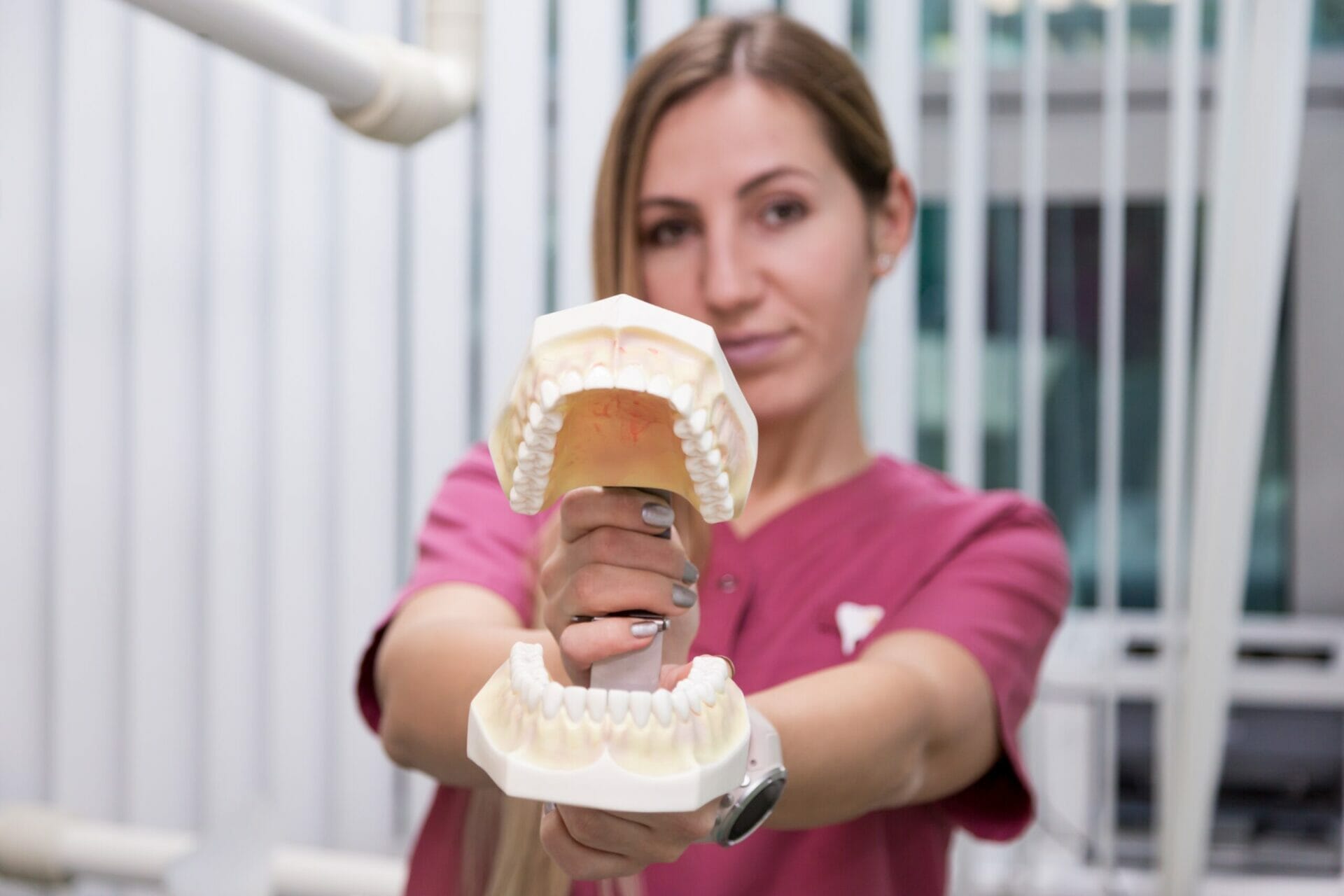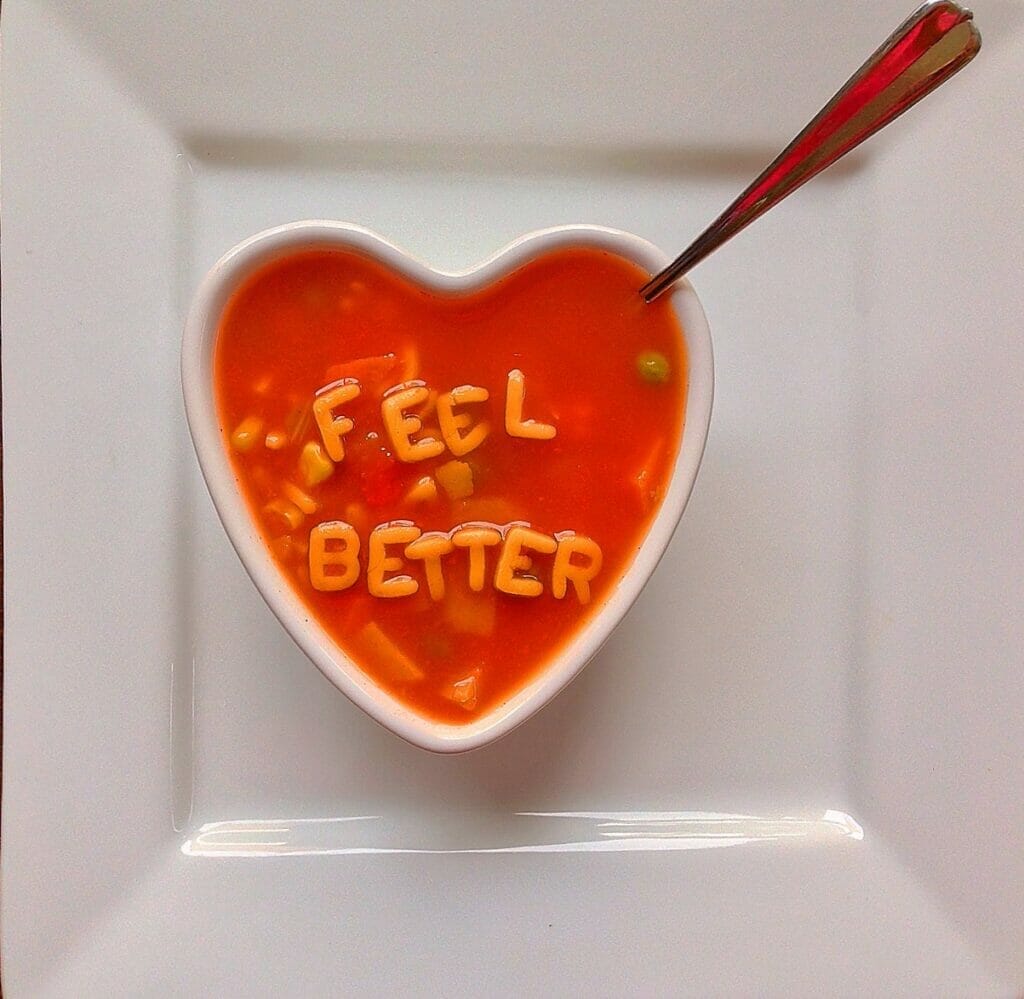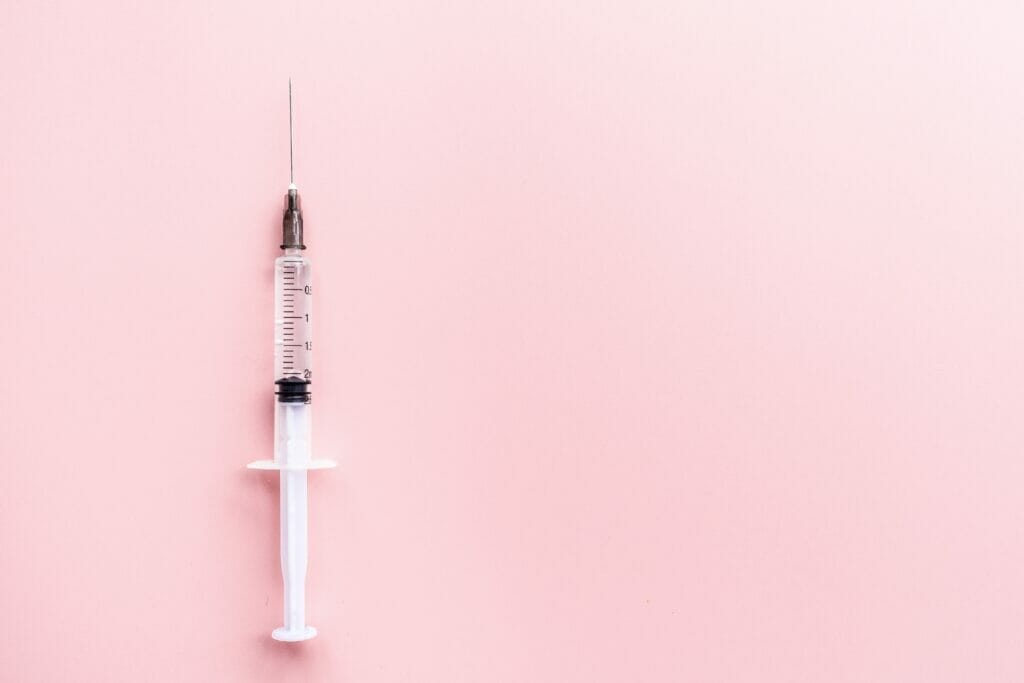
Hi! My name is Kyle Hornby and I'm a Kitchener-Waterloo Dentist. Each week, I sit down at my laptop to write oral health articles that help people improve their lives. Today, I'd like to address the most common questions about Jaw (TMJ) Dysfunction!
First, let's get into a crash course in what the Tempero-Mandibular Joint (TMJ) is so you can understand how dysfunction develops. I'll keep the anatomy lesson brief so you can stay awake for the rest of the article!
So, first thing's first: What does TMJ stand for?
The temporomandibular (tem-pah-roh-man-DIB-u-ler) joint (TMJ) acts like a sliding ball and socket hinge, connecting your jawbone to your skull. You have one of these joints on each side of your jaw.
When you open wide, the bony ball portion of the joint rotates in its socket first but, as you continue to open, this ball begins to slide forward and down a ramp that is located within your cranial base.
Separating the bony ball (or condyle) from the socket (or mandibular fossa) is gel-like articular disc. The articular disc acts like a pillow or shock absorber to cushion bony surfaces during chewing.
TMJ disorders (TMDs) can cause pain in your jaw joint and in the muscles that help to control jaw movement.
So, before we get into many common questions about TMJ Dysfunction, I'd like to quickly address terminology so we're all on the same page when discussing problems with the jaw.
Many people refer to problems with their jaw as TMJ. "I have TMJ so I can't open wide..." or "I do have TMJ so I get a lot of soreness when chewing foods...". What people are describing in these situations is TMJ dysfunction or TMD.
The jaw joint itself is the TMJ. We have 2, one each directly in front of the midpoint of our ears.
The reason that I make the distinction is that, if you suffer from TMD, you may read a lot about it online. So, just know that TMJ refers to the joint itself and TMD refers to problems with the joint causing stiffness, popping and/or pain.

People present with lots of different symptoms when they are experiencing TMJ Dysfunction (TMD). These symptoms can be related to changes in bony structures, connective tissue, as well as the tendons, muscles and ligaments that support TMJ function.
Let's explore each independently, below...
The majority of patients who experience irregularities or dysfunction with their TMJ note a clicking noise or sensation. Sometimes the clicking occurs on opening, closing or during chewing. Some of these patients note that there lower jaw gets "stuck" sometimes during function.
We get many patient questions related to jaw clicking, including:
"How do you fix a clicking TMJ?", and...
"Does TMJ clicking go away?"
In later sections, we'll get to what causes TMJ clicking and how it can be alleviated.
Can TMJ dysfunction cause muscle tightness?
It sure can. The muscles in the temples, cheeks and even the side of the neck work when we clench our teeth and when chewing. It makes sense that jaw issues may lead to pain in these areas.
Most commonly, TMD is spurred on by tooth grinding and this also causes muscle overactivity which leads to inflammation, stiffness and soreness.
Do muscle relaxants work to relieve TMD pain and symptoms? Will discuss this further in sections below.
TMJ Dysfunction has been linked to ringing in the ears or Tinnitus. Some people report that having their jaw in certain positions can increase the intensity of ringing. When TMD is successfully treated it may reduce the incidence and severity of tinnitus and related symptoms.
TMD is often associated with tooth clenching and grinding (bruxing). People who grind their teeth may be over-activating (and fatiguing) the muscles in their temples, cheeks and neck.
This kind of over-activity can lead to muscle tension, soreness and, in some cases, severe aches and pains.
Although, pain in the cheeks and temples is most common in patients who grind their teeth, neck pain can certainly occur.
Your temporomandibular joint is right in front of the mid-point (tragus) of your ear. If you develop TMD it can cause inflammation and soreness.
Occasionally, this takes the form of pain in the ear region and can even cause a ringing sensation (tinnitus) in the ears.
TMJ dysfunction (TMD) has been linked to migraines in some studies. These studies suggest migraines are events related to brain and nerve function and could be triggered by TMD. Migraine sufferers commonly experience symptoms in the TMJs and TMD patients may suffer recurrent headaches related to the disorder.
Many of our patients suffer through some degree of soreness or limited opening related to TMD. They often ask us, "what causes TMJ dysfunction?".
Well, there can be many possible causes. I'd like to outline a few of the more common causes of TMJ dysfunction, below.
Many people are unaware that they clench and grind their teeth during the day and/or at night. This can add many unnecessary chewing cycles to our daily routine and sometimes the force of clenching and grinding far exceeds what our jaws exert during chewing of food.
When we clench and grind our teeth, we place our TMJs under heavy forces. We also fatigue the muscles, tendons and ligaments that enable our TMJs to create jaw movements for speaking and chewing.
All of this extra work and wear and tear can cause inflammation, pain, and muscles that become both sore and stiff.
Because clenching and grinding (bruxism) is so common, when a patient asks me, "What causes TMJ dysfunction?", I often ask them about possible daytime or nighttime grinding.
Less commonly, patients experience an impact injury to their jaw (such as a child falling off their bike or enduring a sports injury to the head).
These kinds of injuries can cause a jaw dislocation or injury to the muscles, ligaments and tendons that keep the jaw in a comfortable resting position. Sometimes, these injuries heal fully with a complete return to normal jaw function. In other cases, a trauma injury to the jaw may have lingering effects such as occasional pain or jaw stiffness.
Can arthritis contribute to TMJ dysfunction? Research has acknowledged the contribution of osteoarthritis to degenerative forms of TMD for a while now. The most common sign of TMD stemming from osteoarthritis is soreness during function and crepitus, which is a grating sound and/or sensation that occurs when bony surfaces rub together or when bone grinds against cartilage.
TMD is commonly diagnosed by your Kitchener Dentist, Medical Specialist, or Oral Surgeon based on symptoms, history and physical examination. You can really get a lot of info by "feel".
You can sense clicking, grinding or crepitus, and popping. These all commonly occur with TMJ dysfunction.
You an also apply pressure to test for TMJ soreness or pain in the muscles that work in concert with the TMJ when you chew or grind your teeth.
In addition to a Dentist's physical examination of your TMJs, medical imaging can help with diagnosis as well. X-rays, CT scans and MRIs can help to show any structural irregularities that may be causing TMD and related symptoms.
MRI (magnetic resonance imaging) is a great way to visualize and assess soft tissues that can become irregular in individuals with TMD. MRI, however, is not a suitable imaging technique for looking at hard structures like bone. If you want to look at bony structures, then x-rays and CT scans are more appropriate techniques.
So, what kind of TMJ changes can be seen on an MRI?
Well, in our first paragraph we talked about the basic components of the TMJ. We know that a bony knob fits into a bony socket, and that a dense fibrous disc acts as a shock absorber or pillow between those hard surfaces. Well, that articular disc can slip out of position so that it doesn't cushion the bony parts of the TMJ as effectively during opening or chewing.
In fact, a disc displacement is one of the most common sources of jaw clicking, popping and pain seen in patients with TMJ dysfunction.
An MRI can effectively show us if your disc is in the correct or incorrect position.
CT (computerized tomography) scans are essentially high-powered, highly detailed x-rays. These scans are great at detailing bony structures associated with the TMJs. While traditional x-ray images provide an average of multiple layers or slices of your jaws and TMJs, a CT scan can actually show you a precise picture at a given depth.
That is, the CT scan takes multiple images at hundreds or thousands of different depths through the TMJ so that you can assess the joint more thoroughly and accurately.
What abnormalities can you see with a CT scan? A CT scan can clearly show positional changes with the bony parts of the TMJs. They can show irregular bone formations (called osteophytes) that occur in degenerative forms of TMJ dysfunction.
Commonly, a thorough diagnosis of TMJ dysfunction is based on both hard and soft tissue parts of the TMJ joints. That is, both CT scans and MRIs are tremendously helpful in providing different information.
TMJ Arthroscopy is another imaging technique for assessing your TMJs.
During an Arthroscopy procedure, your Doctor maneuvers a narrow tube into the joint and an attached camera can help them to view the TMJ in real time. Arthroscopy has the advantage of allowing your doctor to manipulate the camera to gain favorable viewing angles of all TMJ components.
Typically, no, TMD does not just "go away". People can dramatically minimize symptoms, but periodic flare-ups are common.
The key is trying to keep your TMJs in good shape by eliminating "irritators" like gum chewing while controlling things like tooth grinding and bruxism.
Other conservative measures help to keep the muscles and ligaments that guide jaw function loose and limber. We'll talk a bit about this below but massage therapy and physiotherapy do a great job to keep your TMJs functioning comfortably.
There are many approaches to potentially improving TMD outcomes. There are generally 3 categories of treatment: drug or pharmacological treatment, conservative non-invasive therapy, and medical/surgical invasive treatment.
I'll start with simple, conservative and non-invasive approaches for improving TMJ function and then I'll move on to medicinal and invasive/surgical approaches.
These appliances are usually made of soft acrylic or plastic and can be placed over the teeth to provide cushioning. Night guards and splints are most beneficial to patients who clench and grind their teeth during the daytime or nighttime. The cushioning that they provide can relieve pressure on the TMJs that occurs when teeth are clenched together under heavy force.
Physical therapies have a good track record when it comes to relieving TMJ pain and muscle stiffness, both of which are hallmark symptoms of TMJ dysfunction. The most successful of these therapies would be stretching and other functional exercises to strengthen muscles that enable proper TMJ function.
In addition, muscle stimulation with a TENS (Transcutaneous Electrical Nerve Stimulation) unit can help to relieve muscle stiffness and even spasms that can keep the lower jaw in a harmful position.
There are some very simple things that you can do at home to help improve TMJ dysfunction outcomes. These straightforward techniques can increase range of motion in the TMJs and diminish symptoms associated with TMD.

TMJ dysfunction can arise from overuse of the joint, especially in patients who clench and grind their teeth unconsciously. Eating a heavy diet that require lots of chewing can compound problems and make symptoms worse.
If you're going through a TMD flare-up, you may want to avoid tougher foods like meats and chewy candies, pivoting instead to foods that require less intense chewing during consumption.
Soups are great for this but don't feel like you have to live on soup for a week or two. Even more substantial foods that are still soft an easy to chew will work well. Yogurt and eggs are really low-maintenance, high nutrition foods that won't further aggravate your worn out TMJs.
Warm AND cold compresses? Can both of those really work? Well, depending on your TMD symptoms, one of those might be more favourable compared to the other.
Cold temperatures are good for relieving inflammation and related pain. If you suffer from muscle pain around the TMJs, then cold compresses will probably help.
If you suffer from occasional jaw stiffness, then you'll want to heat the muscle tissues that help your jaw to function. Heating will allow you greater muscle pliability and stretch. Generally, heating inflamed tissues will cause increasing soreness, though, so I typically recommend warm compresses for stiff jaws that aren't causing pain.
Acupuncture is an ancient Chinese medical technique whereby thin needles are inserted into nerve-rich areas on the body. By doing this, Acupuncturists aim to influence muscles, organs and other tissues.
Theories of Acupuncture suggest that causing small injuries through needle insertion signals your body to produce a healing response which may include release of natural pain control mediators.
Biofeedback devices contain sensors that can monitor the contractility or tightness of muscles in the body. Using these, you can track tension in muscles around the TMJs.
With constant feedback about muscle tension, the idea is that patient's may be able to initiate relaxation techniques or even muscle stretches and other exercises.
In severe and degenerative cases of TMJ dysfunction, surgical approaches may be recommended. These procedures are commonly carried out by an Oral Surgeon.
In Arthrocentesis, small needles are inserted into the TMJs to drain fluid buildup and inflammatory products that may contribute to ongoing jaw pain.
In some cases, your Kitchener-Waterloo Dentist or Physician may prescribe medication for short-term use to help with TMD. There are a few classes of medication typically prescribed to help:
Pain Relievers. Pain relief medications do nothing to treat active causes of pain. They are completely palliative. These medications may take the form of Tylenol/Acetaminophen or a moderate strength narcotic combination drug like Tylenol 3 (or Tylenol with Codeine). These medications are rarely prescribed for TMD management and would only be a very short term strategy for relief.
Anti-Inflammatories. These medications can relieve pain but also decrease inflammation within muscles or the bony components of the TMJ itself. This control of inflammation can promote some limited healing. These medications may include Toradol (Ketorolac), Naproxen, Alleve, Motrin or Advil.
Muscle Relaxants. Muscle relaxants can help to alleviate muscle stiffness, spasms and limited jaw opening. This can often allow for stretching, muscle healing and increasing range of opening.
It's important to keep in mind that medicinal management of TMJ dysfunction should only be a short-term solution. Consulting your Kitchener Dentist or Family Physician is absolutely essential before initiating a medicinal regimen for relief of TMJ dysfunction.
You may have noticed that when you lay down to sleep or when you lower your jaw forward, your bite changes. This happens because gravity is pulling your lower jaw in a different direction.
You can try it now, if you like. When you lower your chin all the way down and close, your lower jaw shifts forward and your front teeth make contact first on closing. If you lay on your back and then close, your lower jaw shifts backward and only your back teeth make contact.
So, this kind of lower jaw shifting happens to a lesser degree as we walk, lean forward a bit, or stand with poor posture. These things cause only minor positional changes but, if habitual, the strain on your jaw adds up over time.
Poor posture can lead to your lower jaw resting in a strained position. It can stretch the muscles of cheeks, neck and temples that contribute to jaw maintenance and movement. Poor posture can trigger jaw soreness and subsequent headaches.
Postural assessment and training can help people who may have a postural problem contributing to TMJ dysfunction. Your Kitchener Dentist can make a referral to a postural training facility.

An increasing proportion of Dentists believe in utilizing regular botox injections to treat TMJ dysfunction.
Can botox actually help?
Importantly, Botox does not address any of the structural and behavioral causes of TMJ disorder. Therefore, it is advisable to pursue the cause(s) of your TMD. Long-term use of Botox can have very serious consequences. In addition, patients can become hooked on the aesthetic changes achieved with regular Botox injections.
Thanks for reading today's article. Next week, I'll tackle more great oral health topics so please check in!
By Dr. Kyle Hornby, Kitchener Dentist
Our Dentist Office is located in Downtown Kitchener. We are a short drive away for families in Waterloo, Breslau & St. Jacobs. Our central location means we truly offer family dentistry near you!
This article is not intended to be a substitute for professional advice, diagnosis, or treatment. Accordingly, always seek the advice of your Dentist or other healthcare providers regarding a dental condition or treatment.
Services
Routine Dentistry & Tooth Repair
Oral Surgery & Tooth Removal
Prosthetic Dentistry & Tooth Replacement
Protective/Preventive Services
Teeth Whitening
Schedule an Appointment Now
